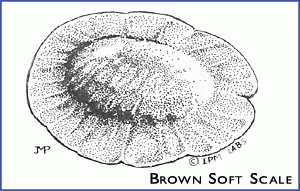Interior Landscapes – Scale and Mealybugs
Description
Scale identity has a large impact on biological control success. Scales are sucking insects about 1/16 to 1/4 inch in diameter. They are covered with a tan or brown scale that protects the soft underparts, and may look like plant bumps. Scales suck plant juices and are classified as soft or armored. Both have hard shells, but the shell may be removed from armored scales by lifting with a sharp knife. Only soft scales and mealybugs secrete a sweet, sticky honeydew which may drop onto lower leaves or floors and support the growth of a black, powdery fungus called sooty mold.. Soft scales usually have one generation per year; armored scales, several. The females are the immobile lumps. Under the scales, each may hatch up to 1000 eggs at a time. When eggs hatch, the first larval stage is mobile and known as crawlers.
Know your mealybugs!! Mealybugs are small, sucking insects with a white, waxy covering that gives them a woolly appearance. One species, the citrus mealybug, Planococcus citri, is oval and pink, with short filaments of wax radiating from the body. Citrus mealybug eggs are laid in cottony appearing groups. The other common mealybug species, the longtailed mealybug, (Pseudococcus longispinus) has long ‘tail’ filaments which may stick up like little spikes from each cottony mass of long-tailed mealybugs. Longtailed mealybugs lay live young, not eggs.
Identifying
There are many species of scale. IPM Labs offers a scale identification service.
Crop Management
Avoid over-fertilizing with nitrogen, and control ants that may protect aphids from predators.
Early Detection
Control mealybugs and scales first by limiting new introductions on new plants brought into the interiorscape. Inspect new plants carefully and control the pests before installation. Monitoring every other week for scales and mealybugs will give you a better probability of early detection and more effective biological control. Examine leaves, stems and leaf axils and plan for action on first detection.
Physical or Chemical Controls
Reduce scale and mealybug populations directly by pruning infested plant parts and carefully removing them so that pests do not accidentally transfer onto clean areas of the plant.
Syringing ”knocking mealybugs off plants with a water spray” is a time-honored method of mealybug control.
Insecticidal soaps, horticultural oils (when not phytotoxic), and insect growth regulators can be effective. Avoid using most residual insecticides for a period of three months prior to planned use of biological controls.
IPM Laboratories, Inc. warrants that the biological controls you receive will be alive and healthy when received and will contain the correct number of the species you ordered. However, as with any pest control measure, success cannot be guaranteed. IPM Laboratories, Inc. makes no guarantee, express or implied, as to the effectiveness of these products.
All images are copyrighted to IPM Laboratories, Inc. and may not be copied or reproduced without permission.


